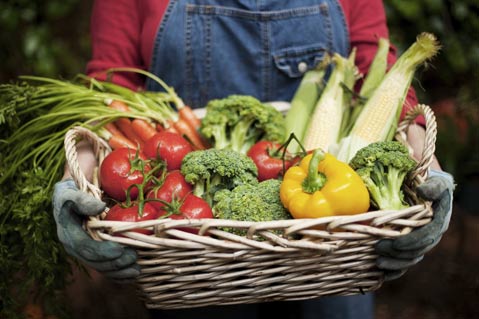A Thriving Garden
Keep Your Veggies Healthy Through Crop Rotation

The following advice is for vegetable gardeners only. If you grow only ornamental plants, this column will have little for your edification. If, however, you relish the taste of the freshest spinach you will ever eat, the utmost in vitamin-packed cucumbers, or the snap of just-picked green beans, you may want to read on. From earliest agricultural times, farmers have learned that planting the same crop in an area year after year leads to problems. They learned to rotate different crops in their fields to alleviate those problems. There are two main reasons for crop rotation: to mitigate pest problems and to maintain soil fertility.
Beneath the soil surface lurk some antagonistic organisms that can attack your pampered plants. One of the worst is the root-knot nematode. These microscopic pests are normal inhabitants of most soils, but when their populations explode, they can cause plenty of damage. They may feed on soil bacteria, fungi, or other species of nematodes, but when they attack plant roots, their presence becomes noticeable in the above-ground portion of the plant. Symptoms of their infection include stunted looking or yellowing leaves and poor or reduced numbers of fruits. The plants may be more susceptible to other fungal and insect pests and can even die. The presence of root nematodes will be revealed by inspection of the roots. Instead of pale, straight roots, they will be twisted and tangled with lots of warts and bumps.
There are toxic treatments to minimize (not remove) root nematodes from the soil, but a much more eco-friendly method of treatment is to interplant with plants that exude substances that may kill or at least suppress the nematodes. One such proven companion plant for susceptible plants is the common marigold. Alternate them along the row, in rows between the rows of vegetables, or surround larger plants with these easy-to-grow and cheerful flowering plants to foil the root predators. Another method (and the subject of our conversation) is to rotate a crop of greens in the cabbage family into the affected area. Mustard may be the most effective, but arugula, broccoli, cauliflower, or any cabbage crop will work, as well. In severe cases, it may take more than one season to make the greatest change. Other resistant crops are all the onion relatives, from leeks to garlic. Sweet corn seems to be on this list, too. It’s hard to accomplish actual crop rotation in small gardens, but a little shifting around is definitely beneficial.
This is but one kind of root interaction that carries over from year to year. There are other root-microorganism associations that may be beneficial or detrimental. Some fungal pests that prove crippling or even fatal, such as verticillium wilt in potatoes, may be effectively controlled by rotating other crops into those beds. The new crop will form associations with a different cohort of microbes or fungi and effectively starve out the pathogen. For the most virulent, it may take more than one year of very resistant plants, such as clover or alfalfa (not exactly fare for the picnic table, but your chickens or rabbits will find them tasty), to eradicate the pest.
Other crops that may benefit by crop rotation are those that require higher levels of different nutrients to thrive. By dividing your crops into the following groups, you can devise a rotation that will benefit each group. The first is leafy crops such as lettuce, spinach, Asian greens, broccoli, and such that require nitrogen. Fruiting vegetables like tomatoes, eggplant, peppers, cucumbers, melons, and squash need phosphorus to produce well. Vegetables that are grown for their roots, beets, carrots, onions, and their like, utilize more potassium. Legumes, all kinds of beans and peas, have the salutary ability to take nitrogen from the air and, with the aid of specialized soil bacteria, incorporate it into their roots. If the plants are turned into the soil after harvest is over, that nitrogen, one of the primary nutrients and necessary for plant growth, is left behind to be used by the next crop.
If you are up on your plant taxonomy, you will notice that these groups more or less fall along family lines. That is another way of looking at the garden plan and moving your different crops around. Cabbage relatives followed by tomato relatives followed by onions and their allies followed by beans, and then begin again. Just a note: Potatoes, although in the tomato family and subject to some of the same pest problems, are harvested for their roots and need potassium to produce well.



